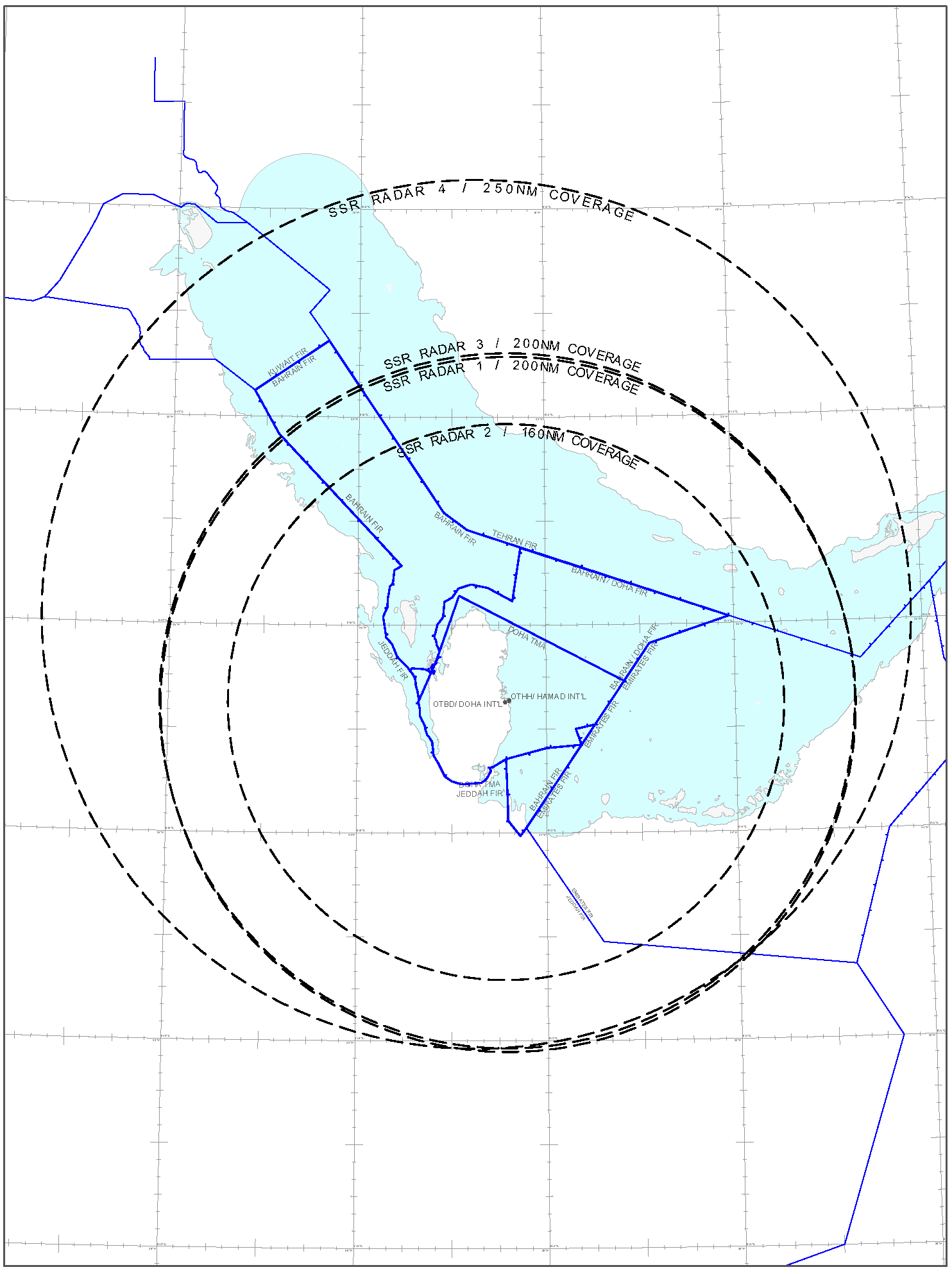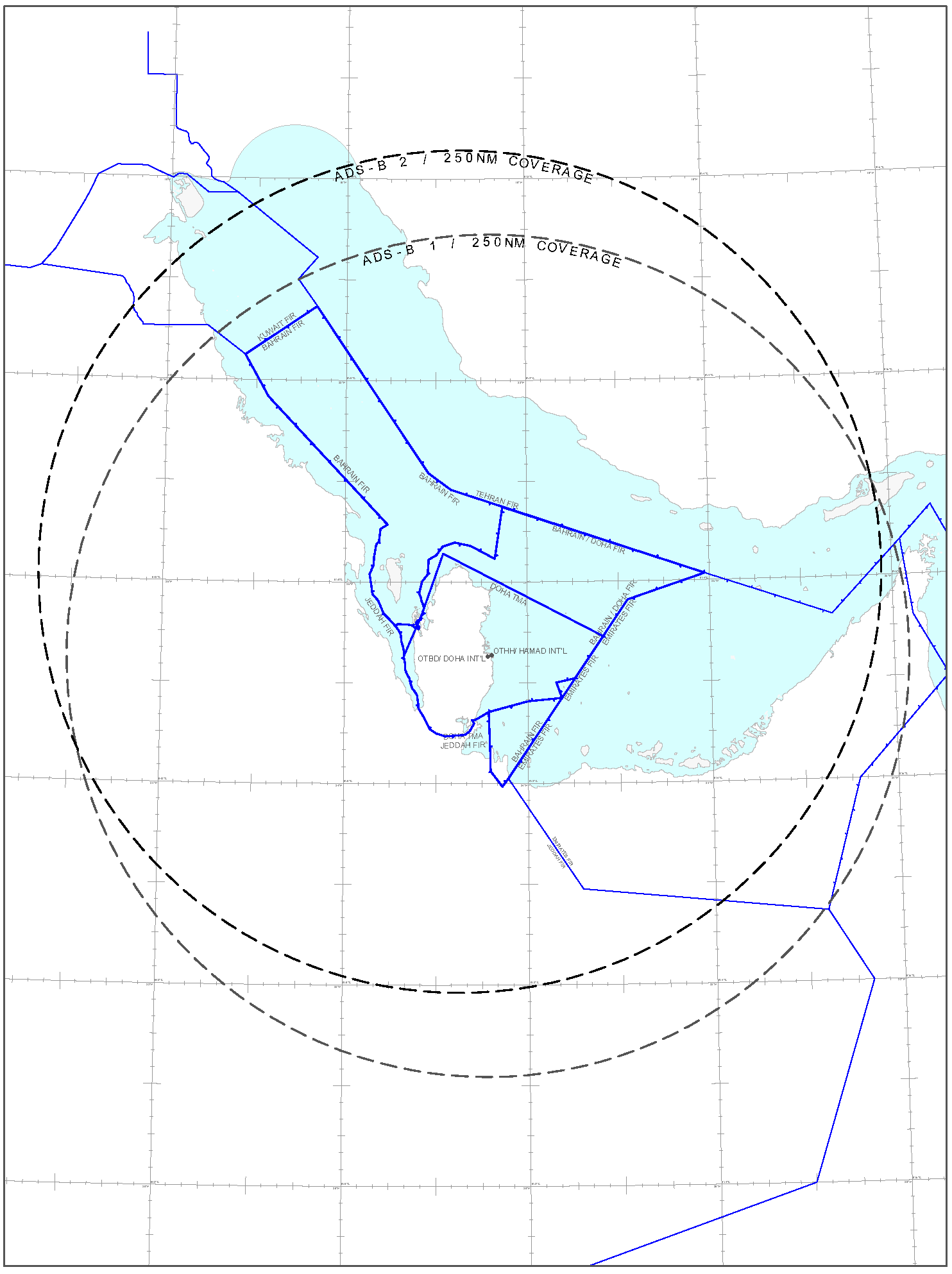ENR 1.6 ATC SURVEILLANCE SERVICES AND PROCEDURES
1 Primary surveillance radar (PSR)
- PRIMARY RADAR 1 (ASR/PSR): DOHA APP – 251419.90N 0513552.20E
- PRIMARY RADAR 2 (ASR/PSR): DOHA APP – 251624.61N 0513513.56E
- PRIMARY RADAR 3 (ASR/PSR): DOHA APP/ACC (En-route Radar) - 260621.10N 0511542.80E
2 Secondary surveillance radar (SSR)
- SECONDARY RADAR 1 (ASR/SSR): DOHA APP - 251419.90N 0513552.20E
- SECONDARY RADAR 2 (ASR/SSR): DOHA APP – 251541.70N 0513428.60E
- SECONDARY RADAR 3 (ASR/SSR): DOHA APP - 251624.61N 0513513.56E
- SECONDARY RADAR 4 (ASR/SSR): DOHA APP/ACC (En-route Radar) - 260621.10N 0511542.80E
- SECONDARY RADAR 1 RANGE: 200 NM centered on position 251419.90N 0513552.20E
- SECONDARY RADAR 2 RANGE: 160 NM centered on position 251541.70N 0513428.60E
- SECONDARY RADAR 3 RANGE: 200 NM centered on position 251624.61N 0513513.56E
- SECONDARY RADAR 4 RANGE (En-route Radar): 250 NM centered on position 260621.10N 0511542.80E
3 Automatic dependent surveillance - Broadcast (ADS-B)
4 SUPPLEMENTARY SERVICES
4.1 General
4.2 The application of radar control service
- Radar separation of arriving, departing and en-route traffic;
- Radar monitoring of arriving, departing and en-route traffic to provide information on any significant deviation from normal flight path;
- Radar vectoring when required;
- Assistance to aircraft in emergency;
- Assistance to aircraft crossing controlled airspace;
- Warnings and position information on other aircraft considered to constitute a hazard;
- Information to assist in the navigation of aircraft;
- Information on observed weather.
- From the centre point of the radar coverage up to 40 NM - 3 NM radar separation.
- Beyond 40 NM - 5 NM radar separation.
| ‘SUPER HEAVY’ | ’UPPER HEAVY’ | ‘LOWER HEAVY’ | ‘UPPER MEDIUM’ | ‘LOWER MEDIUM | ‘LIGHT’ |
|---|---|---|---|---|---|
| ‘CAT-A’ | ‘CAT-B’ | ‘CAT-C’ | ‘CAT-D’ | ‘CAT-E’ | ‘CAT-F’ |
| A388 A124 (…) | A332 A333 A343 A345 A346 A359 B744 B748 B772 B773 B77L B77W B788 B789 IL96 (…) | A306 A30B A310 B703 B752 B753 B762 B763 B764 B783 C135 DC10 DC85 IL76 MD11 TU22 TU95 (…) | A318 A319 A320 A321 AN12 B736 B737 B738 B739 C130 IL18 MD81 MD82 MD83 MD87 MD88 MD90 T204 TU16 (…) | AT43 AT45 AT72 B712 B732 B733 B734 B735 CL60 CRJ1 CRJ2 CRJ7 CRJ9 DH8D E135 E145 E170 E175 E190 E195 F70 F100 GLF4 RJ85 RJ1H (…) | FA10 FA20 D328 E120 BE40 BE45 H25B JS32 JS41 LJ35 LJ60 SF34 P180 C650 C525 C180 C152 (…) |
| Leader | Follower | |||||
|---|---|---|---|---|---|---|
| CAT A | CAT B | CAT C | CAT D | CAT E | CAT F | |
| CAT A | 3 NM | 4 NM | 5 NM | 5 NM | 6 NM | 8 NM |
| CAT B | 3 NM | 4 NM | 4 NM | 5 NM | 7 NM | |
| CAT C | 3 NM | 3 NM | 4 NM | 6 NM | ||
| CAT D | 5 NM | |||||
| CAT E | 4 NM | |||||
| CAT F | 3 NM | |||||
| Leader | Follower | |||||
|---|---|---|---|---|---|---|
| CAT A | CAT B | CAT C | CAT D | CAT E | CAT F | |
| CAT A | 100s | 120s | 140s | 160s | 180s | |
| CAT B | 100s | 120s | 140s | |||
| CAT C | 80s | 100s | 120s | |||
| CAT D | 120s | |||||
| CAT E | 100s | |||||
| CAT F | 80s | |||||
4.3 Emergency procedures
Note: Continuous monitoring of responses on Mode A / 3 Code 7700 is provided.
4.4 Radar and Radio communication failure procedures
4.4.1 Radar failure
In the event of radar failure or loss of radar identification, instructions will be issued to restore non-radar standard separation and the pilot will be instructed to communicate with the parent ATS unit.
4.4.2 Air-ground communication failure
4.4.3 Radio communication failure procedure
In the event of an apparent radio communication failure, the pilot of an aircraft should:
- Maintain Terrain Clearance at all times;
- Squawk 7600;
- Contact appropriate alternate and secondary published ATS frequencies;
- Check aircraft communications equipment;
- Listen to ATIS;
- Broadcast intentions (assuming aircraft transmitter is functioning) and prefix transmission with "TRANSMITTING BLIND"
If a pilot of an aircraft is flying in VMC and is certain that VMC can be maintained, the pilot should:
- Continue to fly in VMC;
- Land at the nearest suitable aerodrome;
- Report arrival by the most expeditious means to the appropriate ATC unit.
If the pilot of an aircraft is flying in IMC or is uncertain that a VMC can be maintained, the pilot should:
- Maintain the last assigned speed and level, or minimum flight altitude if higher, for a period of three (3) minutes following:
- the last assigned level or minimum flight altitude is reached; or
- the last time the transponder is set to Code 7600;
whichever is later, and thereafter adjust level and speed in accordance with the filed flight plan; or
- If being vectored, proceed in the most direct manner possible to rejoin the current flight plan route no later than the next significant point, taking into consideration the applicable minimum flight altitude;
- When on arrival, follow (1) and (2) as applicable, then:
- proceed according to the current flight planned route to appropriate designated navigation aid or fix, if necessary, to ensure compliance with (b) below;
- if cleared on a STAR, commence descent from the holding fix associated with the STAR as close as possible to the Expected Approach Time (EAT) last received and acknowledged. If no EAT has been received, commence descent from the holding fix associated with the STAR as close as possible to the Expected Time of Arrival (ETA) resulting from the flight plan. Follow the Radio Communication Procedure shown on the relevant STAR chart;
- in the event a STAR clearance has not been issued, select code 7600 and follow the STAR most appropriate to the inbound route and last known landing runway.
4.5 Unlawful interference procedures
Pilots of the aircraft in flight subjected to unlawful interference shall endeavour to set the transponder to Mode A Code 7500 to give indication of the situation, unless circumstances warrant the use of A / 3 Code 7700.
Note: Continuous monitoring of responses on Mode A / 3 Code 7500 is provided.
4.6 Graphic portrayal of Secondary Radar coverage areas
 |
4.7 Graphic portrayal of ADS-B coverage areas
 |
|---|